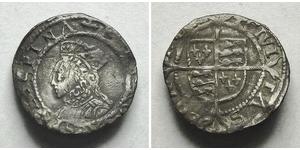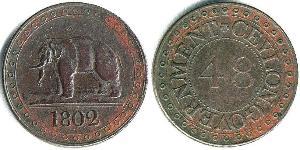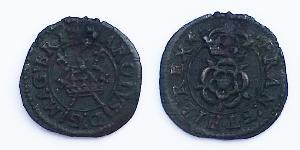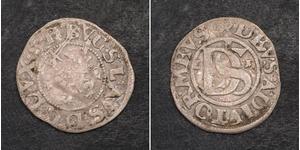(Vendida por $6.0)
1626, Kingdom of Hungary, Ferdinand II. Silver Denar Coin. VF-
Mint Year: 1626
Condition: VF-/VF+
Denomination: Denar
Mint Place: Kremnitz (K-B)
Reference: Huszar 1204 , KM-95.
Diameter: 15mm
Weight: 0.63gm
Material: Silver
Obverse: Madonna with child, flanked by mint initials.
Legend: PATRO . HVNGARI .
Reverse: Date (1626) above Hungarian shield, flanked by mint intials (K-B).
Legend: FER . II . D . G . R . I . S . A . G . H . B . R .
Ferdinand II, Holy Roman Emperor (July 9, 1578 – February 15, 1637), of the House of Habsburg, reigned as Ferdinand II, Archduke of Inner Austria (normally called Ferdinand II of Germany when referred to as Archduke) and Holy Roman Emperor from 1619-1637. He was also the Archduke of Styria (Inner Austria) from 1590–1637, King of Bohemia from 1617-1619 and again from 1620-1637, as well as King of Hungary and Croatia from 1618-1625. The expansion of the ongoing acts of rebellion against his Imperial Governors in Bohemia on May 23rd, 1618 directly triggered the Thirty Years' War, and can be blamed on his religious intolerance toward Protestants.
A devout and very pious Catholic, his recognition as King of Bohemia and suppression of Protestantism precipitated the early events of the Thirty Years' War, and he remained one of the staunchest backers of the Anti-Protestant Counter Reformation efforts as one of the heads of the German Catholic League, prolonging the Thirty Years' Wars by insisting the Edict of Restitution be enforced. The duration of his reign was occupied by confessional and military concerns, and some historians blame him for the large civilian loss of life in the Sack of Magdeburg in 1631, as he'd instructed Count Tilly to enforce the edict upon Saxony—his orders causing Tilly to move the Catholic armies east, ultimately to Leipzig, where they suffered their first substantial defeat at First Breitenfeld.
(July 9, 1578 – February 15, 1637), of the House of Habsburg, reigned as Ferdinand II, Archduke of Inner Austria (normally called Ferdinand II of Germany when referred to as Archduke) and Holy Roman Emperor from 1619-1637. He was also the Archduke of Styria (Inner Austria) from 1590–1637, King of Bohemia from 1617-1619 and again from 1620-1637, as well as King of Hungary and Croatia from 1618-1625. The expansion of the ongoing acts of rebellion against his Imperial Governors in Bohemia on May 23rd, 1618 directly triggered the Thirty Years' War, and can be blamed on his religious intolerance toward Protestants.
A devout and very pious Catholic, his recognition as King of Bohemia and suppression of Protestantism precipitated the early events of the Thirty Years' War, and he remained one of the staunchest backers of the Anti-Protestant Counter Reformation efforts as one of the heads of the German Catholic League, prolonging the Thirty Years' Wars by insisting the Edict of Restitution be enforced. The duration of his reign was occupied by confessional and military concerns, and some historians blame him for the large civilian loss of life in the Sack of Magdeburg in 1631, as he'd instructed Count Tilly to enforce the edict upon Saxony—his orders causing Tilly to move the Catholic armies east, ultimately to Leipzig, where they suffered their first substantial defeat at First Breitenfeld.

1 Penny Reino de Inglaterra (927-1649,16 ...
grupo tiene 6 monedas / 4 precios
Add coin to this group

1 Stiver Sri Lanka / Reino de Gran Breta ...
grupo tiene 7 monedas / 5 precios
Add coin to this group

1 Farthing Reino de Inglaterra (927-1649 ...
grupo tiene 2 monedas / 1 precios
Add coin to this group
2 Stuiver Países Bajos Plata
grupo tiene 33 monedas / 33 precios
⇑






















